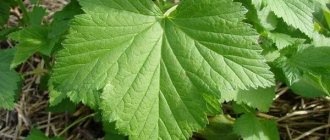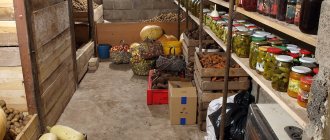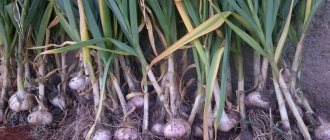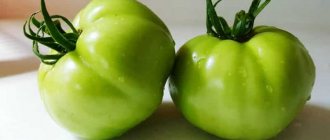Signs of maturity
You can check the maturity of a root crop using common characteristics established by breeders many years ago. With their help, even a novice gardener who is growing root crops for the first time will be able to harvest radishes on time. Signs of the end of the growing season are identical for all varieties, including: green, black and white varieties.
Important!
Like beets, radishes are not collected for storage ahead of time. The root crop is not able to ripen under the conditions of a windowsill and begins to quickly deteriorate. If the fruits are immediately used for food, the cook will not be able to enjoy the characteristically pleasant taste and value of the pulp. The same applies to overripe vegetables; delay in harvesting deprives the plant of its advantages, from taste characteristics to value per 100 g of product.
The two main signs of radish maturity remain the following criteria:
1) the upper part of the plant should lose its elasticity and freshness. In the best case, the tops should dry completely, and in a neutral case, they should wither slightly, changing the color scheme. Green colors should change to yellow or orange-brown tones;
2) radish fruits change density, becoming elastic and hard. Unripe fruits remain soft and are easily damaged when pressed.
The best way to check would be to dig up two or three root vegetables from different parts of the garden. If all the signs coincide, proceed to immediate harvest; otherwise, leave for 7-14 days to ripen, and then check the condition of the crop again.
Harvesting radishes, when to remove them from the garden?
Like most vegetables, digging up black radish from open ground occurs at the end of the growing season. The ripening period depends on the time of planting, the appearance of the first shoots and proper care. With proper watering and complementary feeding, preventive treatment against pests and diseases, root crops ripen on time, and sometimes earlier. If the gardener does not devote time to caring for vegetables, the fruits may not be harvested or the harvest time may be delayed several weeks in advance. According to the practice of beginning gardeners, the approximate harvest time falls in the following months:
1) when planting early-ripening (summer) varieties at the end of spring, harvesting is carried out no earlier than July. Depending on the region, deadlines may deviate by 1-2 weeks forward or backward;
2) mid-season varieties suitable for storage in winter are planted in open ground until mid-June. Fruit ripening occurs quite quickly, and by the end of the summer season, summer residents can collect mature root crops. In the central part and central zone of Russia, most regions of Belarus and Ukraine, collection is carried out from mid-August to early September;
3) late varieties, classified as winter varieties, are harvested from the garden in late autumn, when frosts have not yet replaced the cool temperature. The optimal time for collection is considered to be two months: October and November.
Summer radish harvest dates
For harvesting in the summer, gardeners and gardeners prefer early-ripening varieties with a shortened growing season. Seed material is sown in open ground by mid-May, when the air temperature reaches 17 degrees during the daytime. Varieties of black radish grown for summer are in no way inferior in benefits to mid-season and late varieties. The taste and value of the product remains identical. The only disadvantage of early varieties is short-term storage. Root crops are not grown in large quantities, preferring a small area - approximately 1/2 of the bed.
The maturity of summer radish is achieved in 45-60 days, depending on the variety and care conditions. A delay in fruit weight gain can only be observed in the event of improper care and the arrival of an anticyclone in the region. A large volume of moisture always leads to damage to the fruit while still in the soil.
You can determine when to collect radishes for storage based on the primary signs listed in the article above. In 2021, harvesting rules have not changed. Agronomists call for removing fruits in dry weather, first digging up the fruits from all sides. Excavation from the ground is carried out using the pulling method.
To preserve the freshness of the product for a possible period of time, approximately 30-50 days, it is recommended to immediately cut the tops with pruners, dry the fruits under a canopy for a week, and then put them in a cold cellar or refrigerator shelf, where the air temperature is kept at 3-5 degrees heat.
Secrets of agricultural technology
Successful storage of radish in winter at home begins with timely sowing of seeds and proper agricultural technology.
- Planting of summer varieties with poor keeping quality begins in the first ten days of May.
- Winter ones are sown in June-July. If you plant them earlier, the plant may go into the trunk and bloom, and the root crop may become coarse.
To get healthy vegetables that can last for a long time, care for them correctly:
- Do not thicken the crops, otherwise you will end up with coarse, insipid, deformed root crops.
- Do not grow radishes after their “relatives” - cruciferous vegetables.
- Dig the soil to the depth of a spade bayonet, add humus.
- Moisten the soil well before sowing.
- Do not allow the formation of a soil crust - loosen the soil.
If the soil is mulched with peat, a soil crust will not appear.
Harvesting dates for autumn radishes
Removal of autumn varieties is carried out approximately a month after harvesting the early ones. The time of planting in open ground, the appearance of the first shoots, proper care and weather play a significant role in the exact timing.
In order not to make a mistake with digging, missing over-ripening or, conversely, harvesting ahead of time, it is recommended to dig up at least 2-3 fruits before completely cleaning the beds. A clear example will allow you to understand whether the root vegetables are ripe or not, and how much longer you need to wait.
Digging of fruits should be carried out on warm and dry days. It is best to wait 7-10 days from the last watering so that the soil dries out and the radish becomes hard and absorbs maximum benefits.
Harvesting dates for winter radishes
Harvesting the roots of late vegetables occurs before winter, when the air temperature does not have time to give way to frost. In the Moscow region and the Moscow region, the Urals and Siberia, the Leningrad and Voronezh regions, collection is carried out at different times. However, the rule is the same for all summer residents - digging must be done before frost.
Collection dates always fall in October and November. Later cleaning is carried out only in the southern regions, namely: Kuban, Krasnodar Territory, Rostov Region. The entire crop is not dug up at once due to the risk of harvesting unripe or, conversely, overripe fruits. Summer residents dig up a few fruits at the beginning to make sure they are ready for picking.
It is worth digging up radishes on a dry day, so that the earth does not stick to the equipment, and the crop can be placed under a canopy for complete drying. An increased level of humidity will not allow root crops to be prepared for storage in the cellar, causing rot at the initial stage.
How to store black radish at home?
[ads3]
If there is no cellar, you can take a number of measures and place the radish on the balcony:
- Prepare small wooden boxes
- Insulate the sides of the drawers with an old blanket or other insulation
- Place vegetables in rows in boxes, sprinkling sand on each layer
- Cover with a warm cloth and place on the balcony
- The temperature on the balcony should not fall below 0 degrees
Storing radishes in the refrigerator
Radish can also be stored in the refrigerator for up to 1-3 months without any problems. You need to put it in dry cellophane bags, leaving air there, and tie it. Due to the gradual increase in the concentration of carbon dioxide, radishes can remain fresh for quite a long time and can be used for salads and other dishes until mid-winter.
Below we bring to your attention some more interesting material on this topic, which is taken from here.
There are no difficulties in how to store radishes in the cellar in winter if you follow a number of simple rules. This root vegetable, which has a large amount of vitamins and useful elements, can easily last until spring and at the same time not lose its taste and table qualities. The grown crop must be harvested on time, because unripe or overripe vegetables will not lie and the properties of the radish will deteriorate. It is extremely important not to damage vegetables during harvesting and storage.
Harvesting radishes for storage by region
Summer residents who have many years of experience in growing radishes try to plant summer crops in any weather, and mid-season and late varieties at a certain time, in order to avoid harvesting radishes for storage in warm weather. For winter crops, it is best to store them only if they are harvested in cool but dry weather so that the soil has time to dry out.
It is impossible to predict favorable days for harvesting due to ignorance of the sowing and the selected variety. That is why breeders offer gardeners and gardeners an indicative schedule (table) for harvesting radish by region:
- in the Urals it is proposed to dig up root crops from mid-September to October 10th. This period is ideal provided there is no rain and mid-season and late varieties are planted for winter storage;
- in Central Russia, it is almost impossible to predict the timing. In the regions, three varieties of radish are allowed to be grown at once: early, mid-season and late. And as you know, fruit maturity is achieved in different months. It is recommended to rely on the information indicated on the manufacturer’s seed packaging;
- in the Moscow region, Moscow region and Moscow, collection of late varieties due to bad weather and anticyclone is carried out in advance, from about mid-September and until the 20th of October;
- in Siberia, where there is a harsh climate, radishes are dug up before mid-October so that frosts do not have time to freeze the root crops;
- in the Krasnodar Territory, Kuban and Rostov region, there are no restrictions on the autumn harvest. Warm weather allows harvesting until the end of November.
Before sending the crop for storage, a summer resident who has grown a radish crop should remember the shelf life of the product depending on the variety:
- most summer varieties are not able to maintain freshness and presentation for longer than 4 weeks;
- Daikon, considered a keeping variety, retains its beneficial properties for 2.5 months when properly stored;
- white radish - stored for 30-35 days;
- black radish is the most durable and ideal for winter storage. If there is no damage to the pulp, proper drying and choosing the right room, the product retains its properties for 6-8 months. The advantage of the variety remains the easy tolerance of frosts and weather changes, humidity fluctuations and most bacterial diseases throughout the growing season.
Important!
To answer when to remove radishes from the garden for storage in 2021, you should take into account not only the characteristics of the variety and the growing season, but also adhere to the Lunar calendar, where favorable days are prescribed that exclude the influence of negative phases of the celestial body and barren constellations.
Collection recommendations
- Agronomists advise harvesting only after preparing the cellar and a place for pre-drying the fruits. This trick will save time, facilitating long-term maturation of late varieties.
- You can store radishes not only in the cellar, but also on a cold balcony, refrigerator shelf and at home. However, it is worth remembering that if the vegetable is kept at room temperature, the storage time will be reduced to a minimum.
- Before pulling out vegetables, you should dig up each root vegetable from all sides. Useful advice will help preserve the integrity of the radish without damaging the pulp and skin of the fruit.
- You should not shake off radishes by hitting each other. It is better to dry the plant under a canopy, brushing off dirt and pieces of soil from the surface.
- Only whole and large black radish fruits can be selected for storage. It is better to use damaged ones as food or feed for livestock.
- After digging, it is recommended to immediately remove the tops, which take away the juice from the root crop. The top part should not be cut off completely, leaving 1.5-2 cm at the base.
Is it necessary to do this?
Radish is well suited for long-term storage. However, if the vegetable is not properly prepared for wintering, the duration of storage is reduced. Pruning is a must to increase shelf life. Why?
- The tops suck out all the beneficial substances from the root crop, which leads to both loss of taste and drying out of the vegetable.
- Unremoved roots first begin to grow at high humidity, and then become affected by mold.
If the radish is not trimmed after harvesting, it will gradually rot and will not last long. Rot from uncut leaves easily spreads to vegetables stored nearby. As a result, all the work aimed at growing and harvesting will be meaningless.
Storing the radish harvest
Having learned the timing of the radish harvest for storage in 2021, the summer resident needs to re-examine the fruits for damage before sending the fruits to storage. Only undamaged vegetables that are large in size and elastic when pressed on the pulp are suitable for sending to the cellar.
The fruits are laid out in boxes in layers, sprinkling each new layer with charcoal and sand. If you want to prevent the appearance of pests and bacterial diseases, it is recommended to roll each root vegetable in ground cinnamon, which is a good antibacterial agent, whose aroma repels insects and rodents.
Preparation for storage
Root crops harvested in time must be prepared for storage:
- They start by sorting through the crop, putting aside small and slightly damaged radishes.
- For final drying, place the collected product in a room where it is well ventilated and not exposed to sunlight.
See also
Description of watermelon radish, beneficial properties and harmRead
Cellars or basements also need preparation for storing fresh vegetables:
- To do this, clean the premises of debris, disinfect wooden surfaces with special solutions, and whitewash them with copper sulfate diluted with lime in a ratio of 1:20.
- It is necessary to thoroughly dry the basement before planting the root crops.
- Do not forget about sealing cracks that can become passages for rodents.
All work must be completed 2 weeks before the radish harvest is planted.











